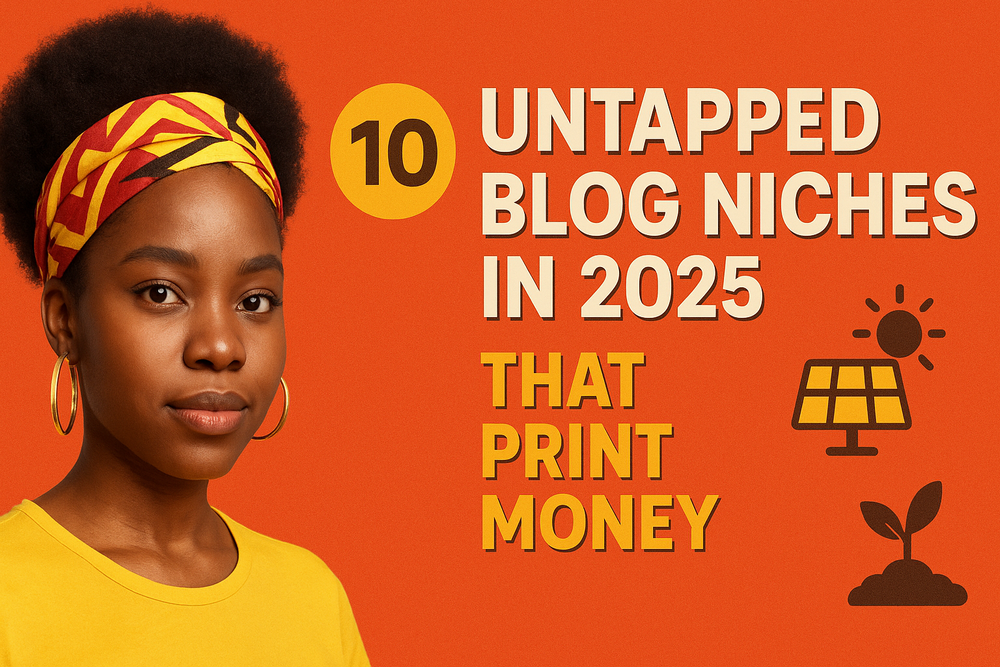Africa’s internet keeps getting faster and cheaper. As a result, new topics rise while old categories feel crowded. This guide breaks down ten profitable ideas, the first posts to write, and the monetization paths to use from day one. You will see simple validation steps so you waste less time.
Why these ideas work
Niches pay when three signals align. First, the audience faces a real pain: money, time, or access. Second, the web lacks clear local answers. Third, advertisers compete to reach the same readers. When you spot that trio, you can move quickly. Use keyword tools sparingly and test interest with short posts and social threads.
Top Blog Niches in 2025 for African Creators
1) Solar and off-grid living. Power remains a daily challenge. Readers want honest reviews of inverters, panels, and batteries that survive heat and bad wiring. Publish setup guides by budget, compare wattage, and include maintenance checklists. For context and data, explore the work of the International Renewable Energy Agency.
2) WhatsApp Business automation. Most SMEs sell through chats. Show how to set up catalogs, quick replies, broadcast lists, and order tracking. Explain templates and compliance in simple language. Point readers to the official WhatsApp Business resources you trust.
3) Small export playbooks. Demand for hibiscus, shea butter, spices, and crafts keeps rising. Walk through sourcing, packaging, lab tests, labeling, customs, and freight forwarders. Add calculators for profit per kilo and tips for buyers in the diaspora.
4) Thrift and resale fashion. “Okrika” and vintage pieces move fast on Instagram and TikTok. Teach curation, cleaning, photo styling, and live-selling scripts. Share markets by city and supplier rules. Include a pricing grid for skirts, denim, and shoes.
5) Street-food and cloud kitchens. Home cooks want side income but fear rent and permits. Create micro-menus, delivery routes, and safe-storage checklists. Test dark-kitchen ideas around office clusters and campuses. Interview delivery riders for practical hacks.
6) Urban micro-farming. Balcony greens, mushroom kits, and backyard chickens cut costs. Document soil mixes, shade hacks, pest control, and harvest timelines. Show weekly photos from seed to plate. Readers love proof.
7) Budget road travel. Flights are expensive, yet buses and shared rides connect cities. Publish route maps, coach reviews, border tips, and weekend itineraries under ₦100k or KSh equivalents. For macro trends and arrivals, scan UNWTO Africa.
8) No-code tools for SMEs. Plenty of shops need websites, forms, and invoices without a developer. Compare builders, payment links, and inventory apps. Share local examples and templates that run on cheap data.
9) Remote-work credentials. Short professional certificates unlock global jobs. Review learning paths, exam costs, and portfolios that attract recruiters. Link to the official Google Career Certificates as one option and compare with other credible tracks.
10) Grassroots sports business. Academies, tournaments, and scouting networks need structure. Teach sponsorship decks, ticketing, and basic safeguarding. Profile kit suppliers and budget fields. Add sample contracts and risk checklists.
How to validate Blog Niches in 2025 fast
First, perform a quick demand scan with Google Trends. Compare two topics by country and city. Then run a five-day test: publish a short post, two social threads, and a simple lead magnet. If you collect fifty emails or more, you have signal. Keep going. If not, adjust angles and retest.
Next, map the problem to a paid outcome. For solar, the outcome is reliable power. For travel, it is safe affordable trips. Frame headlines around outcomes, not tools. Add local prices so readers feel understood. Finally, interview three buyers in your city. Their words shape your copy and product ideas.
Monetization playbook for Blog Niches in 2025
Start with three lanes. One, display ads as the base. Two, affiliates and lead commissions for products readers already want. Three, your own tiny offers: checklists, city guides, or one-hour workshops. Then layer sponsorships once you hit steady traffic. Brands love clear audiences and clean design.
For affiliates, choose merchants that pay locally. Energy stores, learning platforms, hosting, mobility, and sports kits fit well. Add links only where they help the reader decide. Disclose clearly. It builds trust. Later, create a “tools” page and link it from menus and top posts.
Editorial calendar that compounds
Plan six weeks at launch. Week one: five problem posts that answer common questions. Week two: three comparison pieces. Week three: two case studies from your testing. After that, recycle into reels, carousels, and short emails. Because you publish fast, search engines crawl you more often. Your library gains authority even with modest traffic.
SEO and distribution tactics that work now
Use short URLs, specific titles, and scannable subheads. Compress images and remove heavy widgets. Translate key posts into one local language if your readers request it. Share new articles first to WhatsApp lists and LinkedIn groups. Then pitch one expert quote per story to journalists or podcasters. Each quote builds reputation and links. Avoid keyword stuffing; write like a guide who has done the work.
First-post ideas you can ship this weekend
- Solar: “₦200k Starter Solar Kit That Powers a Fan, TV, and Router.”
- WhatsApp: “How to Turn Catalogs into One-Click Invoices.”
- Export: “Profit Math on 25kg of Dried Hibiscus to the UK.”
- Thrift: “From Bale to Sold-Out Live: A 7-Day Flip.”
- Street-food: “Two-Item Lunch Box That Hits 50 Orders.”
- Micro-farming: “Spinach in 30 Days: Shade-Net Setup.”
- Road travel: “Lagos–Accra by Bus: Costs, Borders, Safety.”
- No-code: “A ₦0 Website Stack for One-Person Shops.”
- Credentials: “Portfolio That Lands Your First Remote QA Gig.”
- Sports: “Sponsorship Deck Template for Youth Tournaments.”
Simple metrics that keep you honest
Track three numbers weekly: returning visitors, email sign-ups, and revenue per thousand views. Returning visitors prove usefulness. Email sign-ups show trust. RPM turns traffic into money. Review your top ten pages and fix the slowest ones. Swap heavy images for compressed WebP and lazy-load embeds. Your readers will notice the speed.
Tools and workflows
Write in Google Docs or Notion, then publish on WordPress or a fast static host. Use lightweight themes and caching. For visuals, shoot your own photos with a phone and natural light. Add Canva charts only when they simplify the point. Keep a swipe file of headlines and introductions that worked. Because your library grows, these habits save hours.
The unfair advantage: field notes
People trust proof more than theory. Therefore, test each niche hands-on. Run a tiny solar install, flip three thrift items, or ride the night bus once. Publish the receipts and photos. Your voice becomes the moat. Competitors can copy topics, but they cannot copy your track record.
Final word
Opportunity is everywhere, yet time is limited. Pick one niche from this list and commit to thirty days of focused output. Ship two articles per week, one lead magnet, and a simple offer. If results appear, double down. If not, pivot and keep the momentum. The internet rewards those who execute, listen, and improve.
Discover more from Afroclout
Subscribe to get the latest posts sent to your email.


